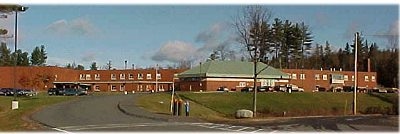
$9.75M SAD 4 budget moved to referendum
GUILFORD — A proposed 2025-26 SAD 4 budget totaling $9,752,463 was approved at the annual district budget meeting during the evening of May 28 in the Piscataquis Community Elementary School cafeteria.
The $9.75 million figure will now go to a referendum vote for final approval on Tuesday, June 10 at the respective polling places in the SAD 4 district communities of Abbot, Cambridge, Guilford, Parkman, Sangerville and Wellington.
The initial draft of the budget was up by 11.6 percent, Superintendent Kelly MacFadyen said as the 2024-25 spending plan totaled a little under $9.25 million.
“This is what we thought we needed but we knew we couldn’t bring it to the citizens of our communities,” she said.
The budget committee worked to bring the increase down to $505,071 or 5.46 percent. A year ago the budget was up 9.4 percent, nearly $775,000.
For 2025-26 the state is allocating $3,264,110 to SAD 4, $147,237 less than the $3.4 million-plus in 2024-25.
In order to receive these funds, the district is required to raise $2,982,900 or a $29,387 increase.
A sum of $2,184,161 in local additional monies is being requested, up $286,979 from a total just under $1.9 million. This warrant article was approved by a count of 35-17 via the required written ballot.
Each community has a proportional local required figure, additional local amount and its costs for the Piscataquis Valley Adult Education Cooperative (SAD 4’s proportional share of the regional program is $53,256 of nearly $450,000).
All district six towns would see an increased assessment in 2025-26. The total combined assessment is $5,220,317 which is up by $369,622 or 7.62 percent.
Abbot would have a $77,330 (8.33 percent) increase in its assessment to $1,005,278; Cambridge’s $367,950 share of the SAD 4 budget is up $29,314 (8.66 percent); Guilford’s share is $1,386,059, up by $52,212 (3.99 percent); Parkman would have a $56,606 (6.06 percent) increase to $990,882; Sangerville’s $1,184,909 share is up $132,814 (12.62 percent); and Wellington’s $285,893 assessment represents a $20,343 (7.68 percent) increase from 2024-25.
Every three years the state requires school districts to determine if they wish to continue with having a referendum to affirm the budget approved at the annual district meeting. If not, the meeting would be the only time to set the finances for the upcoming academic year. A question to continue the district budget meeting/referendum process or not will be on the June 10 ballot.
A question from the audience asked about the work on a regional comprehensive high school application with the Dexter based-SAD 46 through the Maine Department of Education as facility committees from SAD 4 and SAD 46 have been meeting regularly on this.
The application process is a great opportunity, MacFadyen said.
Previously the Milo and Corinth area districts were part of an application but each stopped pursuing the regional comprehensive high school with SAD 4 and SAD 46 last year. In Milo the SAD 41 School Board voted against putting approximately $133,300 of district funds toward startup costs and a site analysis for the pursuit of the school and discontinued its participation in the project.
That came two years after representatives from the four districts met with the MDOE and were told they needed to cover the estimated $800,000 costs of an engineering study and other planning efforts before receiving $100 million in state funding to build the project. MDOE officials said the state would not fund the planning expenses, with these instead to be divided between the school units.
Last year the MDOE offered to fund half of the $800,000 costs with three districts being responsible for the other $400,000 — divided into three $133,300 shares for SAD 4, SAD 41 and SAD 46 after RSU 64 of Corinth withdrew.
Now the state has a new program for a regional comprehensive high school which SAD 4 and SAD 46 are pursuing. Under the new proposal only two participating school districts are needed in the application for a grade 9-16 (post-secondary) consolidated high school to the Maine Capital School Construction program instead of a minimum of three.
“We’re very positive about it because both Dexter and Guilford were willing to put money toward that, we’re both invested,” MacFadyen said.
The first application deadline was in June and this has been extended twice with the revised timeline now in December.
The six-month adjustment may give other applicants time to submit proposals, MacFadyen said, “but we are still actively pursuing that.”
Even if funding is awarded elsewhere, then SAD 4 and SAD 46 may still look at ways to collaborate as the committees have had conversations about this, the superintendent said.
“We understand and recognize we need to do something,” Board Chair Niki Fortier said.
The two districts have already collaborated with sports teams, Fortier pointed out. This spring high school baseball players from Piscataquis Community High School are part of the Dexter Regional High School team, rather than not playing at all due to low numbers in Guilford. Last fall middle school field players traveled to Dexter to be part of the Ridge View Community School squad to have the opportunity to play.
It’s been more than a half decade since SAD 46 headed up an application between itself and SAD 4 for a $100 million first-of-its-kind secondary institution integrated with a career and technical school along with the University of Maine System and the Maine Community College System, and it would support industry training programs. SAD 41 joined later in a non-binding agreement, and then RSU 64 did so.
Projects based in the Madawaska and Houlton areas originally ranked higher, but these proposed schools did not progress as residents could not agree on where to put the building.